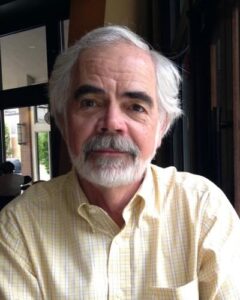In Memoriam: Michael B. Pursley, 1945 – 2025 — by Upamanyu Madhow
 Dr. Michael B. Pursley, a pioneer of wireless communications, passed away on Tuesday, January 14, 2025. He leaves behind a rich legacy in terms of his research contributions and the many students he mentored over his 44-year academic career.
Dr. Michael B. Pursley, a pioneer of wireless communications, passed away on Tuesday, January 14, 2025. He leaves behind a rich legacy in terms of his research contributions and the many students he mentored over his 44-year academic career.
After a bachelor’s and master’s at Purdue, Mike started his graduate research in 1968 at the University of Southern California (USC), collaborating with leading lights in information theory such as Professor Lee Davisson (his PhD advisor at USC) and Professor Bob Gray (Stanford). His PhD thesis developed sophisticated measure-theoretic arguments to obtain the first variable-rate source coding theorems for non-ergodic sources under a fidelity criterion. At the same time, he was well-grounded in the design of practical communication systems through his employment at the Space and Communications Group of the Hughes Aircraft Company in Los Angeles. This combination of practical awareness and theoretical depth led to a truly impactful start to Mike’s academic career when he joined the University of Illinois at Urbana-Champaign (UIUC) in 1974.
When Mike started in academia in 1974, research in wireless communication was driven by military applications; first generation cellular service was launched in the US almost a decade later, in 1983. Military networks required low probability of intercept/detection, and therefore invariably employed some form of spread spectrum communication. Mike made seminal contributions to both of the common approaches to spread spectrum: frequency hopping and direct sequence. The Army’s SINCGARS packet radio network was based on frequency hopping, and Mike made the simple but crucial observation that the impact of interference could be greatly mitigated by Reed-Solomon coding across hops. For direct-sequence spread spectrum, Mike, in collaboration with his colleague Professor Dilip Sarwate at UIUC, provided systematic design guidelines for choice of spreading sequences based on their cross-correlation properties. Mike’s intellectual influence can also be seen in the seminal work of his colleague Professor Bruce Hajek on dynamic decentralized control of multi-access broadcast channels. In short, Mike established himself as perhaps the most impactful researcher in wireless communication within the first few years of his academic career. He was rapidly promoted to full professor at UIUC in six years (in 1980) and elected IEEE Fellow soon after (in 1982).
After a stellar career at UIUC spanning almost two decades, Mike became the first Holcombe Endowed Chair in Electrical and Computer Engineering at Clemson University in 1992, where he stayed until his retirement in 2018. He continued his cutting-edge research on wireless networks throughout, maintaining a vibrant and well-funded research group addressing fundamental bottlenecks via cross-layer design strategies combining signal processing, error control coding, and protocol design. He was an old school PhD advisor, providing his graduate students with the intellectual freedom to develop their technical skills and think through the research problems they were working on, stepping in to provide guidance at critical moments. Not surprisingly, this approach to developing independent-minded scholars inspired a large fraction of his PhD advisees to pursue academic careers, continuing his legacy of impactful academic research in wireless communications. Many others became leaders in industry and government R&D labs.
While running his research program, Mike also made time to write two textbooks, Random Processes in Linear Systems (2002) and Introduction to Digital Communications (2005). He was a dedicated teacher who guided thousands of undergraduate students at UIUC and Clemson through the fundamentals embodied in these books.
Mike’s contributions have been recognized with many honors. He was awarded an IEEE Centennial Medal in 1984, the IEEE Military Communications Conference Ellersick best paper award in 1996, the IEEE Military Communications Conference Award for Technical Achievement in 1999, and an IEEE Millennium Medal in 2000. He received the IEEE Communications Society Edwin Howard Armstrong Achievement Award in 2002, and the IEEE Communication Theory Technical Achievement Award in 2017. Both his undergraduate and graduate alma maters have honored him. He received a distinguished alumnus award from USC in 2005, and was named Outstanding Electrical and Computer Engineer by Purdue in 2008.
Mike’s impact on the technical community went beyond his research and teaching. He is remembered as a generous colleague who worked to make the extended environment around him lively and vital, including interactions with faculty colleagues and their graduate students in his home department and across the international research community. He forged and nourished collaborations and constantly brought in new ideas.
Mike was closely engaged with the communication theory and information theory communities throughout his career. He served as President of the Information Theory Society in 1983. He served on Editorial Boards of the Proceedings of the IEEE and the IEEE Journal on Selected Areas in Communications (including as Guest Editor on a special issue on wireless ad hoc networks), and on the Editorial Advisory Board for the International Journal of Wireless Information Networks.
Mike enjoyed reading history books, hiking to waterfalls, scuba diving and snorkeling adventures with his family. He is survived by his wife Lou Ann, his daughter Jessica, his brother Jan, nieces Alexa and Aimee, and nephew Robert.

